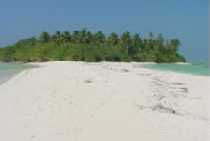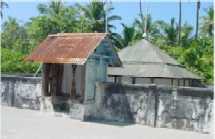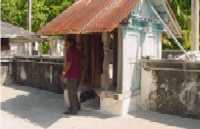|

Matheerah:
On the foreground is the long sandbank where in the olden days
fisherman used to ground their dhonis to improve
fishing. (photo:
huvas)
Over the years, the story continues, the sand bank grew and became an island, and was named Matheerah. Later the honorific
"fulhu" was added to the name and today most people refer to the island as Matheerahfulhu.
The coffin site soon acquired a reputation as a holy site and Hathifushi people built a mausoleum around it.
People from far off islands began to come with gifts and donations to the mausoleum. Word soon spread that if one made a pledge to donate,
one's wishes were fulfilled. Parents brought children to touch their feet on the holy sand and to weigh them against gifts. Fisherman brought their
dhonis to perform 'kanzoori' ceremonies, believing it would improve fishing. On special days like
Eid there were long streams of visitors.

Women dance drummers in 21st century
Maldives: There is little doubt that this art form came
from Africa. (photo:
huvas)
As the mausoleum's reputation grew it gained royal patronage. Over the years many kings and rulers of Maldives visited it (The most recent was President Maumoon Abdul Gayoom). Kings regularly sent flags for its 100 ft long mast. Government granted an endowment for the monument's upkeep, which had grown to 300 rufiya by the 1960s when former President Ibrahim Nasir discontinued it.
Matheerah is located in a large lagoon that forms the Western arc of Ihavandhippolhu Atoll. This lagoon houses two inhabited islands, Huvarafushi and Hathifushi. Matheerah is 10 minutes cruising distance from Hathifushi in a mechanized doni.

The
mausoleum gate: Nailed to it are Indian coins of varying
antiquity. (photo:
huvas)
Matheerah is a beautiful island. On one end is a long sandbank where in the olden days
dhonis were grounded to improve fish catch. The Mausoleum is not very far from there. Near the mausoleum is a shed used for prayer services. On one side is the post used to weigh children.
An interesting feature of the mausoleum gate is a collection of Indian coins nailed to it, dating back to 1887, 1901 and 1917. The road leading from the gate is lined with large earthenware pots, donated by devotees over the years. In earlier times they stored water for visitors.
It is said that a date on the spire of the mausoleum belonged to the 13th century of the Hijri era. It is possible that this was either the date the mausoleum was built or repaired. Thus it could be over 200 years old.
Today, Matheerah is no longer a holy site, becoming a victim of the eroding respect for holy sites. Other sites like Meduziyaray in Male and Mohammed Thakurufan's palace in Utheem have also suffered similar fates. These days hardly anybody comes with gifts. Some people are of the opinion that since it contains an unknown foreigner, it has no value. They don't see anything special in the island. But there are differing opinions. Some people believe that because of its long history Matheerah should become a protected site.
| 



